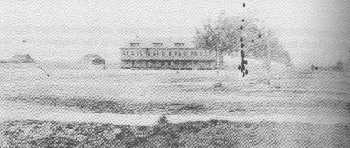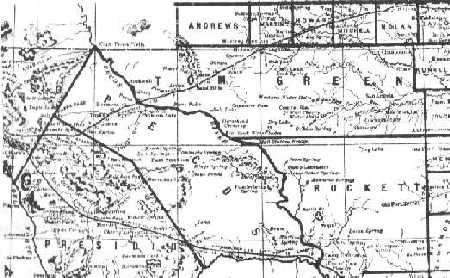![Odessa's first
Court House [# 1]](court1.jpg)
Odessa's First Court House.
Possible date: Jan. 1982. See details below.
 Back to Sanitarium Heritage page.
Back to Sanitarium Heritage page.
![Odessa's first
Court House [# 1]](court1.jpg)
Odessa's First Court House.
Possible date: Jan. 1982. See details below.
Photograph, Courtesy: Ector County Library South West History.

After Survey 27, Odessa was in Tom Green County, with San Angelo the county seat, 150 miles away. Citizens petitioned the Legislature in 1885 to create a new county to include Odessa but it was 1887 before action was taken.
House Bill No. 113 created "The County of Ector" from the western part of Tom Green...
"Beginning at the north west corner of Midland County;
thence South with the line of Midland County 30 Miles;
West 30 Miles; North 30 miles to South boundary of
Andrews County; East 30 miles with the South boundary
of Andrews to the place of beginning."
[with a county 30 miles of boundry on each side; we have 900 square miles in Ector County] The new county was named in honor of Confederate General Matthew D. Ector, Commander of the Noted Ector's Brigade, Judge of the Court of Civil Appeals and former Legislator. It became one of the 36 counties named for men prominent in the Confederacy during the Civil War.
Ector County was attached to Midland County for "judicial, surveying and all other purposes". The legislation passed both houses unanimously and was signed by Governor Sul Ross. This is probably the last thing involving Odessa that has received such unanimity in Austin.
The law required 150 residents to organize a county and was four years before Ector County qualified.
In the meantime, Midland County officials performed the usual governmental functions. Property was put on the tax roll, a school district created, Odessa was designated as the voting box, cases were tried, Odessans served on juries.
A petition containing 156 names requesting legal organization of Ector County was approved by Midland Commissioners Court, November 29, 1890. An election for temporary officials was called January 6, 1891.
It is doubtful if there were actually 150 legal, adult residents here. The 1890 U.S. Census reported 224 men, women and childred. The latter two could not vote, of course. As in the case of many West Texas counties, train Crews, itinerant cowboys, and drifters were probably recruited to help.
C.W. Rathbun was elected as County Judge in the January election, James Boltan was elected Commissioner Precinct 1, J.S. Devereaux, County and District Clerk, E.F. Dawson, Sheriff and Tax Collector. At the first Commissioners Court meeting January 16, Rathbun appointed J.W. Driver Commissioner Precinct 2 and M.G. Buchanan Commissioner Precinct 3. The Court appointed George Hogg as County Attorney, T.B. Blair as Animal and Hide Inspector and J.M. Jackson As County Treasurer.
February 9, 1891... Commissioners failed to appear for meeting so Judge issued Warrants asking the Sheriff to arrest and bring them in.
February 23... J.L. Gray appointed Commissioner Precinct 4.
July 16.. Accepted deed to grounds and courthouse (the former sanitarium building) from the Odessa Improvement and Irrigation Company. The deed contained restrictions against liquor and revisionary clause if the land was no longer used for county purposes.
In August, an election was called to keep hogs from running at large. A Wolf Scalp Fund was created with fees to be paid for the following scalps or ears: Rabbits $1.00, Wild Cats $1.00, Panthers $20.00, Coyotes $2.00.
The Courthouse was remodeled for $750.00 and painted for $300.00 in January, 1892. During the year salaries were set: Judge $500.00 per year, Clerk $ $600.00, Sheriff $366.00.
Courtesy, The Flavor Of Texas, 1891-1991 & E.B. Ribble Plus data from Exchange Club, 1881-1981.
This was the first courthouse of Ector County, and it stood in the same location as the present one. It was a white, two-story frame building. The top floor was used for the courtroom of the county and the district courts. The ground floor had four rooms; two rooms were used for the school, one room was used for the sheriff, and the fourth room was used jointly by the county and district clerks.
This structure was only used 12 years. During this time it was also used as a land office, when the state allowed individuals to file on four sections of land. There is in existence a photograph of the land rush, which the Ector County Library possesses, which depits the people trying to get into the courthouse door.
According to the federal census, in 1890 the population of Ector County was only 224. However, by 1900, the population has shrunk to a meager 51 people. In between 1900 and 1910 the population grew to 1,178, and it was during this period of population expansion that in 1904 the commissioner's court ordered an election concerning whether a new courthouse and jail were to be built for Ector County. On March 15, 1904, an election was held, The bonds were to run for 40 years at four per cent per annum, and were redeemable at the pleasure of the county at any time after five years. Such election must have been hotly contested, for there were a total of 112 votes cast, 45 against and 67 for, showing a slim margin of 22 votes in favor of the bonds.
It was ordered by the court that the new courthouse was to be built just east and in front of the old one. One W.T. Malone was ordered to the sandhills [Quito] Quarry to examine the sandstone to see if it could be used in the erecting of the new courthouse.
On July 29, 1904, the cornerstone of the Ector County courthouse was laid. There were several things that were placed in the cornerstone for the purpose of posterity, some of which are letters that, to my knowledge, have never been published.
The railroad in Ector County was the biggest thing that the county had, so it was only natural that the agent of the railroad, J.M. Frame, place a letter in the cornerstone, which he did. Mr. Frame indicates in his letter that there was "nothing here but stock raising though maybe farming or granger county some day, not much prospects for the town to grow". Although his prediction did not come true as to the growth of the town, still as to stock raising and farming he is correct today.
The Courthouse itself was a two-story red stone structure. In its day, the courthouse probably was one of Odessa's finest attractions. On the opening day of the courthouse in 1904, a masquerade ball was held in the courthouse and an immense tray of artificial flowers was passed to the gentleman present, each picking one flower.
Courtesy: This is a reprint from the Odessa American, Sunday, Oct. 29, 1967; page 1-E.